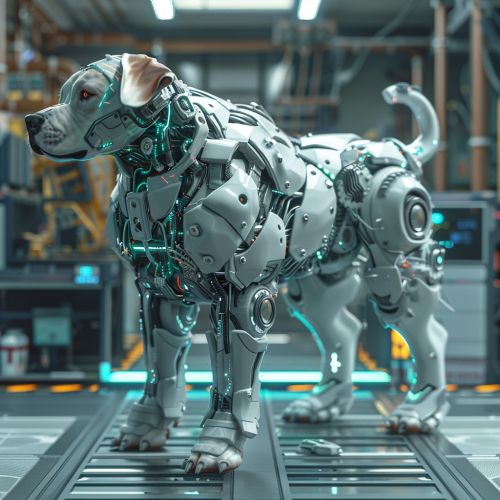Cybernetic Dog
Introduction
A cybernetic dog refers to a canine that has been integrated with cybernetic enhancements, which may include mechanical, electronic, or biological augmentations. These enhancements can serve various purposes, such as improving physical capabilities, enhancing sensory perception, or enabling direct communication with digital systems. The concept of cybernetic dogs intersects with fields such as robotics, biotechnology, and artificial intelligence.
Historical Background
The idea of cybernetic enhancements for animals, including dogs, has its roots in early cybernetics research during the mid-20th century. Norbert Wiener, a pioneer in cybernetics, laid the groundwork for understanding how biological and mechanical systems could interact. Initial experiments in cybernetics often involved simpler organisms, but as technology advanced, the focus shifted to more complex beings, including dogs.
Technological Components
Mechanical Augmentations
Mechanical augmentations in cybernetic dogs may include prosthetic limbs, exoskeletons, and internal support structures. These enhancements are designed to replace or support damaged biological limbs, providing improved mobility and strength. Advanced materials such as titanium and carbon fiber are commonly used due to their strength and lightweight properties.
Electronic Enhancements
Electronic enhancements often involve the integration of sensors, microchips, and communication devices. These components can be used for tracking, monitoring health parameters, and enabling direct communication with handlers. For example, RFID chips can be implanted for identification purposes, while more advanced systems might include GPS tracking and real-time health monitoring.
Biological Augmentations
Biological augmentations involve genetic modifications or the integration of biological tissues with electronic components. Techniques such as CRISPR can be used to enhance specific traits, such as muscle strength or sensory perception. Additionally, biohybrid systems that combine living tissues with electronic components are being explored to create more seamless integrations.


Applications
Military and Law Enforcement
Cybernetic dogs are increasingly being utilized in military and law enforcement contexts. Their enhanced physical capabilities and sensory perception make them valuable assets for tasks such as bomb detection, search and rescue, and surveillance. The integration of communication devices allows handlers to receive real-time data and issue commands remotely.
Medical and Therapeutic Uses
In the medical field, cybernetic dogs can serve as therapy animals or assist individuals with disabilities. Enhancements such as prosthetic limbs and sensory aids can enable these dogs to perform tasks that would be challenging for non-enhanced animals. Additionally, their ability to monitor health parameters can provide valuable data for medical professionals.
Research and Development
Cybernetic dogs are also used in research to study the interactions between biological and artificial systems. These studies can provide insights into the development of advanced prosthetics, neural interfaces, and biohybrid systems. Research in this area often involves collaboration between fields such as neuroscience, materials science, and computer science.
Ethical Considerations
The integration of cybernetic enhancements in dogs raises several ethical questions. Concerns include the welfare of the animals, the potential for exploitation, and the long-term implications of genetic modifications. Ethical guidelines and regulations are essential to ensure that the well-being of cybernetic dogs is prioritized and that their use is justified.
Future Directions
The future of cybernetic dogs is likely to involve more advanced and seamless integrations of biological and artificial components. Emerging technologies such as nanotechnology and synthetic biology hold promise for creating more sophisticated enhancements. Additionally, advancements in machine learning and artificial intelligence could enable more autonomous and intelligent cybernetic dogs.
